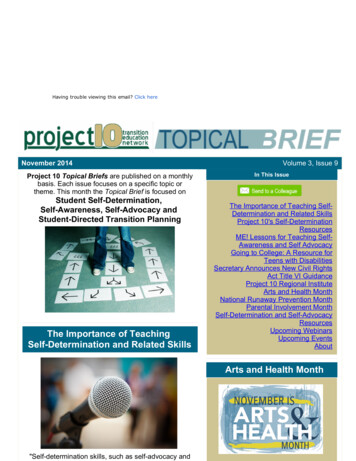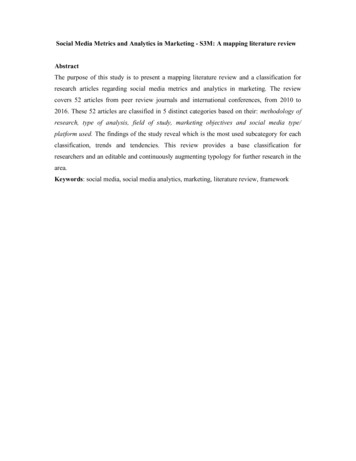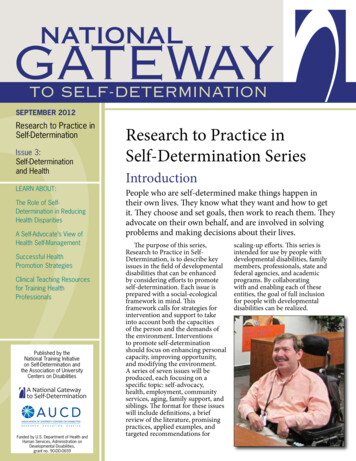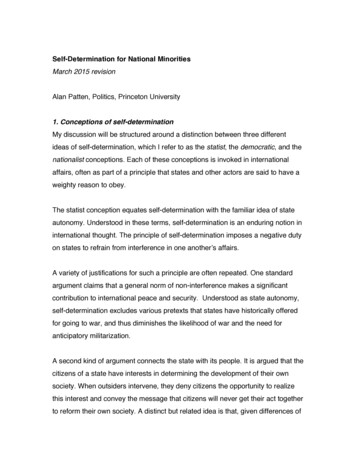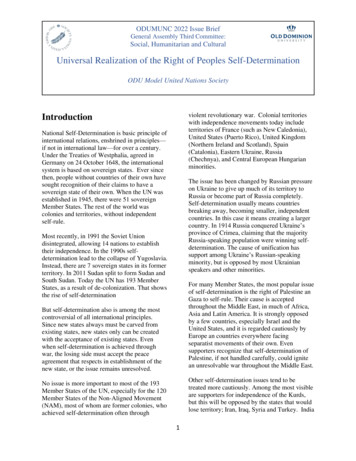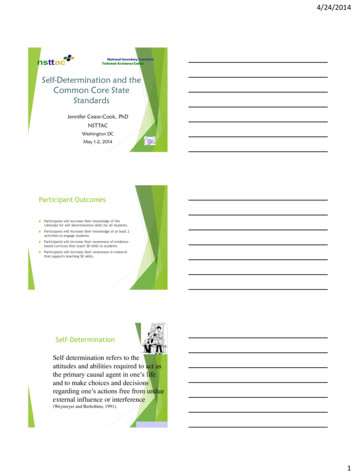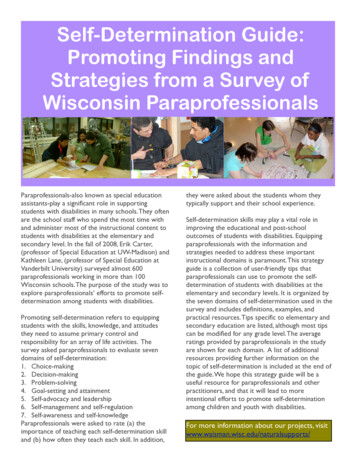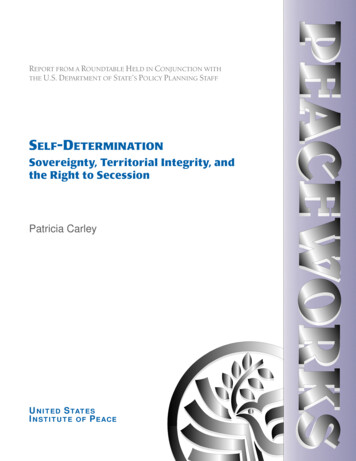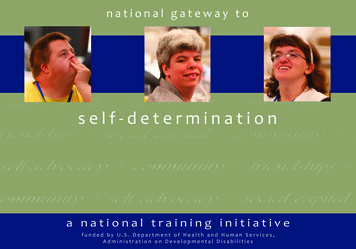
Transcription
national gateway tosocial capital friendships community self-determinationriendships social capital community Fself-advocacy community friendships community self advocacy social capital a national training initiativefunded by U.S. Department of Health and Human Services,Administration on Developmental Disabilities
Bob Williams, formerADD Commissioner, reviews theDisability Timeline at SABE 2010.
missionFall 2010: The purpose of this booklet is to provide an overview ofactivities to date of the National Gateway to Self-Determination projectand describe highlighted activities and products currently available.The overall goal of the National Gateway to Self-Determination is “toestablish a sustainable, evidence-based training system that enhancesself-determination training programs that lead to quality of life outcomesfor individuals with developmental disabilities throughout the lifespan.”There are a number of important beliefs upon which the National Gatewayto Self-Determination project is founded, as discussed below.1. Scaling up efforts to promote self-determination (SD) are mosteffective when they are conducted in an enabling context focused onthe people they are intended to benefit. In the case of this project, thiscontext is established by a social-ecological framework that acknowledgesthe importance of the interactions occurring between people and theirenvironments throughout their lifespan.2. UCEDDs have a responsibility to develop evidence-based practices andto support the translation of research into practice. As such, it is importantthat scaling up efforts to promote self-determination be developed andtested within the framework of research-based models, theories ofself-determination, and research-based or evidence-driven practices.3. Within the context of the Gateway to Self-Determination, thedevelopment of self-determination is not an end in and of itself, but rathera viable means to accessing an improved quality of life. Thus, evaluationstrategies incorporated into efforts to promote self-determination mustaddress not only increased knowledge and skills leading to enhancedself-determination, but also include strategies for ongoing evaluation ofimproved quality of life outcomes for individuals with disabilities.4. Finally, people with developmental disabilities must be equal partnersin the planning, development, implementation, and evaluation of anyeffort to promote self-determination. Self-advocates will remain keypartners throughout all aspects of the project’s implementation.People with developmentaldisabilities must be equal partners in the planning,development, implementation, and evaluation ofany effort to promote self-determination.mission
collaborationsleadership consortiumThe Leadership Consortium is made up of five primary UCEDDs joiningtogether with the Association of University Centers on Disabilityand Administration on Developmental Disabilities to lead this effortto scale up and promote SD nationally. The Leadership Consortiumincludes:The University of Missouri Kansas City Institute for HumanDevelopment (the Missouri UCEDD), Carl F. Calkins, Director.http://www.ihd.umkc.eduThe Kansas University Center on Developmental Disabilities (theKansas UCEDD), Michael Wehmeyer, Director.http://www.kucdd.orgWestchester Institute for Human Development (a New York UCEDD),in affiliation with New York Medical College,Ansley Bacon, Director. http://community.wihd.orgadditional ucedd partnersThe participation of additional UCEDDs is key to the success of thisproject. Other UCEDDs that provide substantial support include:The University of Minnesota Institute on Community Integration,David Johnson & Brian Abery.http://ici.umn.edu/welcome/network.htmlThe University of Alaska Anchorage Center for Human Development,Karen Ward. http://www.alaskachd.orgTexas A&M University Center on Disability and Development, DalunZhang. http://cdd.tamu.eduThe University of Delaware Center for Disability Studies, SteveEidelman. http://www.hdfs.udel.eduThe University of Oregon Center on HumanDevelopment (an Oregon UCEDD), Hill Walker,Director. http://ucedd.uoregon.eduThe Missouri UCEDD serves as the lead organizationand fiscal agent for the consortium, andDr. Carl F. Calkins from the Missouri UCEDD andDr. Michael Wehmeyer from the Kansas UCEDD serveas co-project directors.The University of Illinois at Chicago Institute onDisability and Human Development (the IllinoisUCEDD), Tamar Heller, Director.http://www.idhd.orgFor additional information on any aspect ofthe project, please contact Dr. Carl F. Calkins at816.235.1755 or calkinsc@umkc.edu.The Association of University Centers on Disability,George Jesien, Executive Director.http://www.aucd.orgThe Administration on Developmental Disabilities,Jennifer Johnson and Suad Jama, Program own University National Center for CulturalCompetence, Tawara Goode. ndex.htmlMike Wehmeyer & Nancy Warddeliver a keynote address atSABE 2010.
sel f - d e t e r m i nation allianceA primary objective is the inclusion in every phase of the project of “all the players” in the disabilitycommunity, from University Centers for Excellence in Developmental Disabilities, to governmentagencies, and most importantly to individuals and families. The Self-Determination Alliance supports andadvises the project and is made up of the following organizations:College of Direct Support is an internet-based curriculum for DirectSupport Professionals creating a workforce to support individuals with disabilities - “Building Careers, Supporting Lives.” The curriculum, values, andmission are based on the premise that all people should live life to its fullest in community-based settings. http://info.collegeofdirectsupport.comCouncil on Community Advocacy assists AUCD to advance policy andpractice for and with people with disabilities, their families, andcommunities. COCA serves as a model and resource for others desiringto infuse the participation of people with disabilities and family membersinto program planning, research, and evaluation. http://www.aucd.orgNational Association of Councils on Developmental Disabilities promotes and enhances the outcomes of member councils in developing andsustaining inclusive communities and self-directed services and supportsfor individuals with developmental disabilities. http://www.nacdd.orgNational Association of State Directors of DevelopmentalDisabilities Services is a nonprofit organization, established in 1964, toimprove and expand public services to people with intellectual and otherdevelopmental disabilities. http://www.nasddds.orgNational Disability Rights Network works through training and technical assistance, legal support, and legislative advocacy to create a societyin which people with disabilities are afforded equality of opportunity andare able to fully participate by exercising choice and self-determination.http://www.napas.orgNational Family VoicesBetty Williams, President of SABE, &(including Kids asNancy Thaler, NASDDDSSelf-Advocates) aims toachieve family-centered care for all children and youth with special healthcare needs and/or disabilities by providing tools to make informed decisions, advocate for improved public/private policies, build partnershipsamong professionals and families, and serve as a health care resource.http://www.familyvoices.orgNational Leadership Consortium at the University of Delaware iscommitted to helping develop the next generation of leaders who arepassionate about quality, have the necessary management and financialskills, are capable of assembling top-notch teams of caring staff, and havea solid commitment to progressive values. http://www.nlcdd.orgSelf-Advocates Becoming Empowered (SABE) is the self-advocacyorganization of the United States. Founded in 1990, they have beenworking hard for the full inclusion of people with developmentaldisabilities in the community. http://www.sabeusa.orgSibling Leadership Network provides siblings of individuals withdisabilities the information, support, and tools to advocate with theirbrothers and sisters and to promote the issues important to them andtheir entire families. http://www.siblingleadership.orgcollaborations
conceptsdefinitionMuch of the initial work of the projectinvolved coming to a consensus on aphilosophical approach and definitionof self-determination and the variouselements involved. Being able toarticulate a common understandingof self-determination helps everyoneinvolved in the project work moreeffectively toward the same goal.Included within this document are somedefinitions and conceptual elements:We understand self-determination torefer to a characteristic of a personthat leads them to make choicesand decisions based on their ownpreferences and interests, to monitorand regulate their own actions, and to begoal-oriented and self-directing.The DD Act definition of self-determinedactions, as noted below, suggests thatboth the abilities of the person andthe opportunities presented by theenvironment contribute to the degreeof self-determination that can beexpressed.In line with this approach, we haveadopted a social-ecological approach bywhich we consider self-determinationto reflect the interaction of factors inboth the personal and n individual with developmental disabilites, with assistance:ahas the ability and opportunity to make choices & decisions;ahas the ability and opportunity to exercise control over services, supports, and other assistance;ahas the authority to control resources and obtain needed services;ahas the opportunity to participate in and contribute to their communities;ahas the support, including financial, to advocate, develop leadership skills, become trained as aself-advocate, and participate in coalitions and policy-making.
s p e cial journal issueA major task of the initial phase of the project wasthe development of an evidence-basedframework to guide the activities of the projectand communicate the intended long-termoutcomes associated with this initiative, whichinclude improved opportunities to becomeself-determined, greater social inclusion,and enhanced quality of life for people withdevelopmental disabilities. Through thedevelopment of this framework, a series of fourin-depth articles was created to help define andclarify specific issues involved inself-determination.These articles will be published as a Special Issueof Exceptionality entitled “Scaling Up Efforts toPromote Self-Determination” and reflect theconsensus from the project partners on a socialecological framework within which to focusefforts to scale up interventions to promoteself-determination. This product provides thetheoretical framework upon which a multitude ofother products will be developed for a variety ofaudiences.“A Social-Ecological Approach to PromoteSelf-Determination” This first article describesa social-ecological approach for promoting andenhancing the self-determination of people withdevelopmental disabilities. A five-level modelis presented, based upon the interaction ofperson and environmental factors, that identifiesa series of social mediator variables (i.e. socialeffectiveness, social capital, social inclusion),which can successfully influenceself-determination improvement efforts andenhance the efficacy of self-determinationinterventions.“Personal Self-Determination and ModeratingVariables that Impact Efforts to PromoteSelf-Determination” The second article providesdetail with regard to how we understand theself-determination construct and discussesmoderator variables and how such variablesimpact the design and implementation ofinterventions to promote self-determination.Importantly, this article discusses the roleof culture as a critical moderator variable inconsidering interventions to promote theself-determination of people with developmentaldisabilities from minority or traditionallyunderrepresented groups.“Self-Determination Across the Life Span: Issuesand Gaps” This article synthesizes the literatureon self-determination across the life span witha focus on identifying gaps that exist betweentheory, research, and evidence-based practices.Using a life-stages approach, it first examines issues across life phases, and then examinescross-cutting topics (employment, abuse and ne-audience: UCEDDs & service providersglect, and health) that are relevant during severalage ranges. A life span approach to scaling up efforts to promote self-determination takes into account both the person’s developmental stage andthe social ecological conditions of his or her life.While its expression for individuals with developmental disabilities can begin at the earliest stages,the level of self-determination generally increasesthroughout adolescence and early adulthood.“Lessons Learned in Scaling Up EffectivePractices: Implications for PromotingSelf-Determination within DevelopmentalDisabilities” This final article examines howscaling up efforts should be conducted. Humanservice and educational professionals agree thatimplementation science is the missing link thatconnects research outcomes to the deliveryof effective practices. Implementation scienceinforms the scaling up of effective practices andaddresses critical issues like social marketing,adoption decisions, capacity building, training,technical assistance, consumer participation andsatisfaction, and long-term impact. This articledefines scaling up, provides examples of practicesthat have successfully scaled up, examines leversand incentives for scaling up efforts to promoteself-determination, and describes the Gateway toSelf-Determination project’s template for scalingup efforts to promote self-determination.concepts
conceptsHow are we learning about the importance of self-determinationin the lives of self-advocates and their families?Story-Telling Initiative: Oneimportant element of the project isthe story-telling initiative throughwhich self-advocates “write theirown story.” The story-tellingsession is perhaps best describedas a guided interview throughwhich different topics areintroduced. The goal of the sessionis to allow the self-advocate totell their own story as it relatesto different topics, and describetheir experiences in successfully(or maybe not successfully) living aself-determined life as it relates tothe topic.Regarding the topic of “housing”or “independent living” we havetwo stories - Megan who is living onher own and Chad who has found agreat program that has allowed himto make his own choices.Megan’s story: I’m living on myown, after 20 some odd years,and I had been been fighting withmy parents. I’m really close tomy dad, not as close to my mom,because my mom thinks of me as a“disability kid” not as a child. So itkind of tore me up inside. I talkedto my case manager and said I haveto get out before I go ballistic. NowI’m living closer to the city, becauseI like getting out and getting active.I moved into my own place onmy birthday – the best birthdaypresent ever. It’s amazing.Chad’s story: I didn’t know how tocook for myself or anything. I calledup a resource and explained mysituation. I said “Look - I can’t liveon my own anymore.” He broughtme to his support/resource program where I started a whole newlife. I now have a whole new life formyself, I’m an advocate. I’ve donea lot of good work in the advocacyfield. All this would never have happened had I not gotten intothe program. I’m advocatingfor people to get the helpthat they should get. Theprogram showed me how tocook, how to budget, helpedme make something of mylife. All this never would havehappened without their help.I would have ended up insome institution.Self-Administered Surveyon Self-Determination UsingiPads at SABE 2010: One ofthe activities of the project wasUsing iPad to take SD Surveyto examine opportunities for SDalso prove useful in measuring thefrom items from the National Coreimpact of various local and stateIndicators. Twenty-seven items wereinterventions over time.selected that related to the conceptof SD as defined by the project.Working closely with AbleLinkThese items were then rewordedTechnologies (of Colorado Springs,into a simplified survey that couldCO), a specially designed iPadbe self-administered using Appleinterface was developed that wasiPads operated by self-advocateseasy for self-advocates to understandthemselves. Gathering data pertainingand navigate on their own. Theto self-advocates’ reports of theirsoftware displayed and read eachopportunities for self-determinationquestion and possible answerwould prove valuable, allowing forout loud to the participant, whocollection of an extensive datasetthen simply touched the answerwithout time-consuming interviews,of their choice. With minimaland affording privacy and a sense ofinstruction, nearly three-quartersindependence while taking part in aof the participating self-advocatessurvey process.were able to complete the surveyindependently.The SABE conference providedan ideal opportunity to pilot thesurvey and collect baseline data onattendees’ status relative to variousindicators of opportunities for SDcaptured by the survey items (i.e.,choice; employment; communityinclusion; etc.). We could also testthe viability of gathering responsesto these questions directly in iPadsrather than engaging in typical NCIface-to-face interviews. This willVolunteers from UCEDDs and othersources assisted the self-advocatesin the survey. The research protocolallowed for informed consent andvoluntary, anonymous participation.In a little more than two days, staffwere able to support over 240 peopleto take part in the survey, yieldingapproimately 220 valid surveys. Thesedata are currently being analyzed.
task forcesThrough an extensive literature review, the Gateway to Self-Determinationidentified a number of barriers and training gaps. Based on this review, theLeadership Consortium developed five task forces, each of which will beresponsible for outcomes related to one of the following areas:1. Aging and Life Span Issues: Aging successfully evolves from exercising SDto create a successful and productive life. It is a dynamic process involvingindividuals in their environment including the historical and culturalcontext. The chair of this task force is Tamar Heller at the University ofIllinois at Chicago, Dept of Disability & Human Development (UCEDD).2. Health: SD has potential for improving the health of people withdisabilities. People with disabilities are at greater risk for secondary andchronic conditions; have higher rates of preventable complications andpremature death; are more likely to engage in poor health behaviors; andare less likely to obtain affordable and appropriate medical care, earlydisease identification or preventive screening, or access health promotionactivities. The chair of this task force is Ansley Bacon at the WestchesterInstitute for Human Development (UCEDD) in affiliation with the New YorkMedical College.3. Employment: SD is the essential element for enhancing individualcontrol and involvement in employment, and ultimately job satisfaction andsuccess. The chair for this task force is Michael Wehmeyer at the KansasUniversity Center on Developmental Disabilities (UCEDD) at the Universityof Kansas.4. Community Living: In many places people with disabilities areinstitutionalized, denying them freedom and opportunity and excludingthem from the fabric and mainstream of community life.audience: UCEDDs & service providers5. Self-Advocacy: Self-advocacy skillsare critically important if adults withdisabilities are to become independent,self-determined people who participatemeaningfully in making major lifedecisions. The chair of this task force isCarl Calkins at the University of MissouriKansas City Institute for HumanDevelopment (UCEDD).The consortium will also focus oncross-cutting themes that impact all five task force areas as they relate toself-determination: social networks, technology, and cultural competency.The chair for each task force was chosen based on areas of expertise. Theywill determine and coordinate a plan to address the need for research,training, and development of interventions for their focus areas.Each chair is also responsible for recruiting additional members andassigning tasks. Members will be drawn from other national UCEDDS, theNational Self-Determination Alliance, and other state/national groups withexpertise in the identified areas.During Phase II of the project, each task force will be responsible for thefollowing activities within its focus area: 1. Plan a scope of work for the taskforce; 2. Conduct a needs assessment/evaluation of SD resources withinthe focus area; and 3. Develop and publish a Special Topic Brief designedto provide strategies, discuss research, evaluate policy analysis, and tellsuccess stories for self-advocates, families, and practitioners.concepts
resourcesresource guideCurrently under development is the Resource Guide, comprised ofapproaches, strategies, resources, and curricula to promoteself-determination. We are actively seeking materials for possibleinclusion in the guide.This resource guide will be a valuable tool for use by a broadaudience of individuals including people with developmentaldisabilities, professionals, direct support personnel, parents andsiblings, educators, and self-advocates. A web-accessible, nationallisting of recommended programs and resources to promoteself-determination that can be utilized by all constituencies is indevelopment.aBe consistent with prevailing approaches and values in the field ofdevelopmental disabilities.If you would like to submit a resource for consideration in the guide,please visit www.aucd.org/ngsd/nom for complete details orcontact: George Gotto, UMKC Institute for Human Development(UCEDD), 816.235.5334, gottog@umkc.edu.Be a part of this important product by submitting your materials forreview and possible inclusion. If you are aware of other authors whohave developed similar materials to promote self-determination,please pass this information on to them.The resources included in the guide meet the following criteria:aAddress one or more of the person-specific elements ofself-determination and/or enhance the social or physical environmentso that it is likely to support a person to be more self-determining;aBe likely to result in personal outcomes and quality of lifeimprovement consistent with self-determination (e.g., opportunitiesfor supported living, employment, community participation andmembership, and personal relationships);aHave been used successfully by or with people havingdevelopmental disabilities, their families, or their supportprofessionals;aHave some formative or summative evaluation data associated withthem;Have you developed or implementedeffective interventions or practices topromote self-determination? If so, submitthem for possible inclusion in theResource Guide!audience: ucedds, self-advocates, families, & service providers
web sitehttp://aucd.org/ngsdA major product of the project is the National Gateway toSelf-Determination Web site. The Web site is a portal to information,stories, resources, training, and much more. The site provides a singleaccess for self-advocates, professionals, policy-makers, and the generalpublic on current best- and evidence-based practices in enhancingself-determination in the lives of people with developmental andintellectual disabilities, as well as any individual.Scaling Up SD refers to manyprocesses and procedures thathelp organizations at the community, state, and national level to sustainbest- and evidence-based practices to promote self-determination overtime. These policy and organizational supports to promoteself-determination occur through a number of initiatives by a variety ofstakeholders and are highlighted in this section of the Web site.The Listserve is an open listserve, meant to facilitate communicationregarding self-determination. Your emails and responses to this listservewill be viewed by all listserve members. Log on to the Web site and join thelistserve now.SD News & Events includes news about conferences, AUCDupcoming events, and recent NTI accomplishments. Past events andpostings are archived in an easy-to-use format.The SD in Practice section features video interview and stories. Examplesof current video postings include:aDreams: This video shows children and adults who have Down syndrometalking about their dreams and what they’re proud of in their lives.aSuccess & Self-Determination: Individuals with disabilities talk aboutliving self-determined lives in high school, college, and careers.SD Links provides convenient links to organizations and self-determinationrelated Web pages.Visit the Web site often, as it is continually evolving and expanding. Asalways, if you have comments or suggestions on how the site can be moreeffective, please drop us a note to: calkinsc@umkc.edu.Related Material includes fact sheets, calendar postings of special events,research, and more, all organized by topic (aging, abuse & neglect, health,technology, etc).audience: ucedds, self-advocates, families, & service providersresources
resourcesadditional resources for ucedds & professionalsPractice Guidelines: Promotingself-determination has become best practicein the education of students with intellectualand developmental disabilities. The purposeof this practice guide is to review andsummarize existing practices that enhanceself-determination and the empirical supportassociated with those practices. SD is aconstruct with multiple facets and as suchthere will be no single practice or packageof practices for achieving self-determinationthat applies to all people or all contexts. Weoffer in this practice guide first a summaryof the way in which self-determination hasbeen conceptualized for the purposes of thisPractice Guide and by the Gateway toSelf-Determination project, then anorganizational framework for linking practicesthat will enhance self-determination, andfinally a brief summary of the researchliterature supporting use of these practices.Our hope is that this guide will not onlyprovide recommendations for educators, butalso prove useful in fostering research, policy,and systems efforts to expand the role ofself-determination in the lives of people withdisabilities.White Paper on Social Capital: A series ofscholarly papers will be developed on varioustopics. To date, the first paper on the topic ofSocial Capital is complete. This paper discussesa systematic approach to develop socialcapital for people with disabilities. As Portes(1998) observed, social networks are not anatural given but must be constructed throughsystematic effort and the development ofappropriate investment strategies. To fullyrealize the potential benefits of social capitalfor persons with developmental disabilities, itis essential that systematic steps be taken tooperationalize this construct in a way thatcreates a path for developing strategies toaccess and increase it.self-determination and people withdisabilities. The intent of this slide show isto provide a synthesis of major findings inthe area of self-determination pertainingto youth and adults with intellectual anddevelopmental disabilities. The findings inthis slide show come from a comprehensivereview of the literature on self-determinationpublished in 2007 in the journal Exceptionality,as well as from a comprehensive review of theresearch published subsequent to this review.Lectures & PowerPoints: These productsprovide excellent professional levelintroductions to self-determination.SustainabilityBy providing valuable resources to the field,the Gateway to Self-Determination projectwill remain a viable presence in the disabilitycommunity long after the conclusion of theproject. Major activities planned for the latterportion of the project will enhance thelong-term impact to the field and include:“What is Self-Determination & Why is itImportant to People with DevelopmentalDisabilities?” This video lecture andPowerPoint by Michael Wehmeyer give anin-depth introduction to self-determinationwith discussions around expectations,definitions, and philosophical doctrine, asapplied to disability, supports, outcomes,research, and more. This lecture is targetedto graduate level students and professionalsinterested in a thorough introduction to thesubject.“Self-Determination and People withIntellectual and Developmental Disabilities:What Does The Research Tell Us?” Thereexists an already substantive and still growingliterature base pertaining toState Summits & Pilots: A limited numberof pilot summits are planned to develop thescaling up options for states.Scaling Up UCEDDs Symposium: to bepresented at AUCD at the start of the finalyear of the project providing UCEDD facultyand staff with in-depth training methodsand strategies to scale up efforts to promoteself-determination in their state or territory.A “Train the Trainer” Implementation Manualwill be a product from this activity.
a d d i t i onal resources for individual s & f a m i l i e s“What is Self-Determination andWhy Is It Important?” is a multimedia product consisting of aprint-based, 16-page full-colorpublication and an accompanyingWhat Is Self-Determination Web-presence that elaborates onand Why Is It Important?stories and themes introduced inA National Gatewayto Self-Determinationthe print publication. The product,both print and Web-based,provides a user-friendly, attractive introduction to self-determinationand its importance in the lives of people with developmentaldisabilities by relating the stories of self-advocates, as well as theirfamily and support staff. These stories, presented in pictures andnarrative in the print product and via videos streamed online,provide information about the role of self-determination in th
self-determination training programs that lead to quality of life outcomes for individuals with developmental disabilities throughout the lifespan." There are a number of important beliefs upon which the National Gateway to Self-Determination project is founded, as discussed below. 1. Scaling up efforts to promote self-determination (SD) are most
